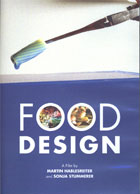
Food Design 2009
Distributed by Icarus Films, 32 Court St., 21st Floor, Brooklyn, NY 11201; 800-876-1710
Produced by Martin Hablesreiter and Sonja Stummerer
Directed by Martin Hablesreiter and Sonja Stummerer
DVD, color, 52 min.
Sr. High - Adult
Food, Nutrition, Psychology, Science, Chemistry, Business
Date Entered: 09/20/2010
Reviewed by Janis Tyhurst, Reference Librarian, George Fox UniversityFood Design is a well produced film full of information that will appeal to nutrition students, marketing students, design students and anyone with an interest in how food products come to be.
The film is in German and French with English subtitles. The subtitles are accurately translated. There are 7 chapters that can be viewed independently of the other chapters, making it a good choice for classrooms. The chapters are:
- We Want More
- Consumer Driven Research
- Appearance and Smell
- Sound and Consistency
- Functionality
- Symbols
- Processing
Among the interesting facts provided by the film are the different types of research done in the areas of appearance, sound effects and functionality. The way a food looks psychologically affects how people perceive that food, e.g. red colored foods tend to be sweeter, while black colored foods remind people of decay. Research on how food sounds or smells also influences how much we enjoy the food and various examples of the tests that are done are explained and demonstrated.
Early examples of food design date back centuries. Bagels have a hole in the center so that they could be put on a string and more easily carried; cheese was put into round forms so that it could be rolled into the wine cellar when it solidified. Centuries ago, only the wealthy had dinnerware, so the rest of the population used flat breads as edible plates for the rest of their food. Industrial food design’s purpose today is to make functional food more attractive. For example, in the 1970s, cold cuts in Germany and Austria were standardized to fit precisely on a Kaiser roll. Certain pasta forms retain more sauce than others. In today’s modern mobile society, food is designed to fit in the hand without the use of utensils—think hamburgers and pizza.
Another aspect that is explored is the creation of snack food for children. Not only is taste, appearance and smell critical to this market segment, it also needs to appeal to the mothers. Extensive research is done on children’s snacks to create a “clean” product—one that does not create a mess that has to be cleaned up. Questions such as how long it takes for ice cream to melt are rigorously examined. The success of food design is apparent when someone who hates tomatoes will eat ketchup, or the child who won’t eat fish but will eat breaded and fried fish sticks.
Perhaps the most fascinating section is that on food symbols. There are a plethora of symbolic foods that have political, religious, sexual or national meanings. Two thousand years ago, the croissant was created as a sacrifice to the ancient moon goddess, Selene. Braided bread became a replacement sacrifice for that of braided hair. Some societies ate the brains and/or organs of worthy opponents to ingest characteristics such as wisdom, courage, or strength. Societies also abstain from eating certain types of foods to set themselves apart from surrounding cultures.
Studies have been done on whether individual personalities are expressed in the foods one eats or in the way they eat it. Jean Anthelme Brillat-Savarin, a French gastronome of the 18th century, wrote “Tell me what you eat and I will tell you who you are.” But after watching Food Design, you may wonder if what you eat—and thus who you are—is determined more by marketers than by society or personality.